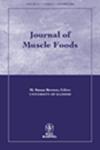The aim of this study was to compare chemical parameters, fatty acid composition and mineral contents of farm animal meats which are marketed in Turkey. Different kinds of meats were purchased from the meat market including beef, lamb, broiler, turkey, ostrich and quail meat, which are mostly preferred for different reasons by consumers. However, little information exists about the composition of meats of different farm animal species. The results of proximate analysis showed that the high level of protein (24.38%) and low level crude fat (1.19 ± 0.13%) were found in turkey meats, while the low level of protein (18.75%) and high level fat (8.79%) were found in lamb meats. The fatty acid compositions of meats were in the range of 22.68–48.37% for saturated, 21.38–42.45% for monounsaturated and 3.75–47.47% for polyunsaturated acids. The highest micro mineral was determined as zinc (5.7417 ppm) in lamb and ostrich (5.0923 ppm).
Consumers attitudes toward meat “safety” greatly affect their overall choices and the variety of meat types available for sale. Some meats are more likely to cause heart disease – saturated fats and trans fats. These fats are usually found in foods from animals such as meat milk, cheese and butter. The dietary saturated fatty acids elevate serum cholesterol concentrations, whereas polyunsaturated fatty acids reduce serum cholesterol concentrations and monounsaturated fatty acids have little or no effect. Therefore, knowledge concerning the exact fatty acid composition of the meat is extremely important for the consumer and processing sector. This study provides comparative information to consumer and processing sector about proximate and fatty acid compositions and mineral contents of beef, lamb, broiler, turkey, ostrich and quail meats.


